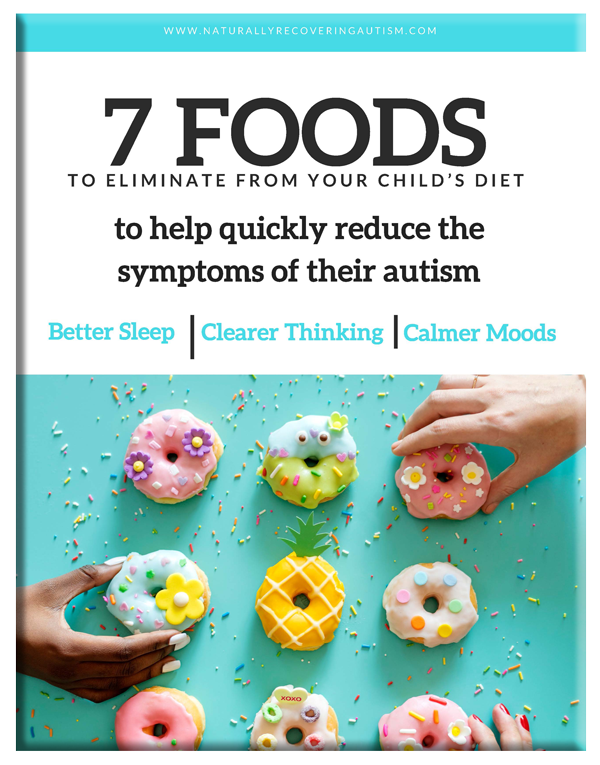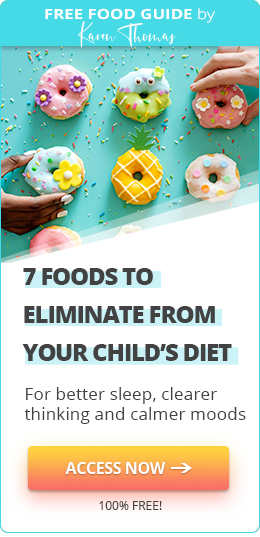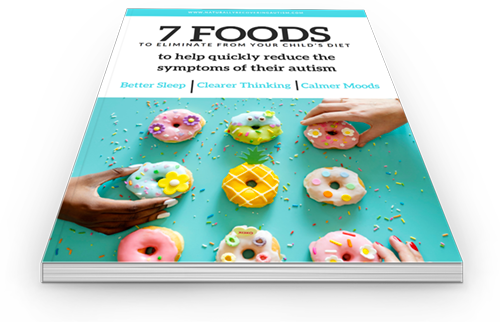Artificial sweeteners are unhealthy alternatives. For example aspartame is an excitotoxin which means it literally can excite brain cells to death. Current evidence indicates that sucralose and saccharin could influence the gut microbiota by reducing the good bacteria in the gut, and it has been linked to cancers. For instance, in one study, scientists fed Splenda to rats for 12 weeks. Splenda is an artificial sweetener that contains sucralose. The authors concluded that, after 12 weeks, the rats had fewer beneficial gut bacteria.
Hypoglycemia or Low Blood Sugar
Hypoglycemia is a condition that comes from low blood sugar or glucose. Behavioral outbursts, anxiety, and lack of ability to think clearly come from the brain being starved of its energy supply. When it has been too long since our last meal or snack, blood sugar drops and our brain cannot function properly. If we eat too many sugars and refined carbohydrates, our body responds by releasing large amounts of insulin to counteract the effects of all of the sugar. This is especially hard on the liver and can cause it to become congested creating further physical and behavioral problems.
Hypoglycemia or low blood sugar can trigger many unhealthy reactions in our bodies. Excess insulin secretion can contribute to many severe disorders including allergies, asthma, alcoholism, cancer, heart disease, chronic fatigue, depression, diabetes, and more.
The Glycemic Index
The glycemic index or GI is a way to measure the physiological effect that various foods have on blood glucose levels. Knowing this can help you to control those hunger and energy fluctuations during the day by eating better choices. This becomes very easy in a short period of time. Once you begin to learn what foods are high and which are low it starts to fall into common sense.
Based on scientific data, foods have been tested to show their effect on blood glucose levels. Foods with a low GI will have less of an effect on blood sugar than foods with a high GI. The foods we eat have a direct impact on how quickly our bodies are able to digest them. Slower digestion gives your body a chance to regulate the release of insulin better.
Protein is a great choice because it is low on the glycemic index. When we eat protein, it takes a longer time for our body to break it down. The higher nutrient content combined with a low GI will also assist in satiation. Our body will be fed a source of food it can utilize and one that takes much longer to digest. This keeps us feeling full longer and does not have a negative impact on blood sugar.
It is vital to feed your children small amounts of protein throughout the day to minimize their body’s cravings for carbohydrates, the very food that converts into sugar and feeds the Candida. Foods higher on the glycemic index also have a greater likelihood of creating hyperactivity and then a “sugar crash” with loss of all energy within an hour or two after consumption. We do not want to use protein in excess as too much can be hard on the liver. Small amounts that are spread out will suffice to keep blood sugar balanced.
We commonly offer grains such as rice, starchy vegetables, and fruit. These tend to feed pathogenic bacteria, as they turn to sugars in the body, and he gets worse. The main food sources for pathogenic microbes are sugars and carbohydrates. This is often when we begin seeing more physical and emotional symptoms in our child.
Sugars, High Fructose Corn Syrup and the Liver
Sugars, especially high fructose corn syrup, are a big part of the problem for the liver also. Blood sugars and metabolic syndrome must be put under control. Non-alcoholic fatty liver is an accumulation of triglycerides and fat in the liver that causes it to start poisoning itself. The skin often tells us if these fats are not being properly broken down. Rashes, hives, very dry or flaky skin are all common indicators.
Food Allergies, Low Immunity and Nutritional Deficiency

When the gut is imbalanced, the body is toxic. Food allergies are created and the ongoing inflammation is a trigger for the adrenal glands, along with the immune system, to fight for the body’s health and wellbeing. A drop in blood sugar or hypoglycemia can be created by a lack of absorption of nutrients due to pathogenic bacteria in the gut. Hypoglycemia is another strong trigger for the adrenal glands to release Cortisol.
Histamines
When there is leaky gut induced by candida spores the body can have a hard time breaking down histamines.
Histamines contribute to many symptoms including increased stimming, anxiety, sleep issues, heart palpitations, and more.
By reducing stomach acid histamines contribute to further issues with digestion working against your efforts to heal the gut, and is a common reason for GERD or acid back up.
Adrenal Fatigue
Hypoglycemia is very hard on the adrenal glands and can contribute to adrenal fatigue. It is a challenge during the day, but also very hard on your system at night. During sleep, Candida feeds on your blood sugar.
Hyperactivity and Negative Behaviors
When blood sugar drops, it causes low glucose levels in the brain. Thus, the brain’s energy supply is low. This causes the brain to secrete toxins such as glutamate. The result is negative behavior and mis-wiring in the brain. This is especially disruptive when the brain is developing and also causes adrenal problems. Hyperactivity, an inability to handle emotions, and aggressive behavior are common symptoms.
Ability to Utilize Proteins and Their Effect on Hormones
An imbalance of adrenal hormones can impair the body’s ability to grow and to recover from illness and injury. This imbalance also disrupts the body’s ability to build and utilize protein, or to perform what is known as protein synthesis. Proteins are needed for the health of cells and other necessary hormones in the body.
Candida, Sugar Cravings, and Malnourishment
Candida requires sugar as food. This can come in the source of any chemical that ends in “ose” such as glucose, fructose, or sucrose. Carbohydrates such as bread and pasta are also converted by the body into sugars that act as another food source for candida. When glucose (from sugars and carbohydrates) is digested by Candida, it creates the alcoholic chemical ethanol and its extremely toxic by-product, acetaldehyde.
Candida and this alcohol, acetaldehyde, are transferred via the placenta to the developing fetus and are capable of doing harm during development. After birth, the baby continues to receive alcohol through the mother’s breast milk. Alcohol can cause malnutrition by preventing the body from digesting proteins.
Candida albicans or yeast can become overgrown in the gut. When this happens it not only affects the health of our gut, immune system, and brain but our blood sugar, as well. We will crave carbohydrates and sugar because candida uses it as its food supply. Candida also causes the gut to leak and allows for undigested food particles to enter the bloodstream causing food allergies. Enzyme production decreases and bloating increases.
This all triggers an immune response that alerts the adrenals to have a stress response. Worse, because the lining of the gut is damaged it is not properly absorbing vital nutrients from the foods we eat. We then can become malnourished, even though we are eating a lot, and we remain hungry because our body and brain are starving for nutrition. This can be why your child wakes in the middle of the night as the brain is starving for glucose. Feeding your child a light snack with healthy protein and fat such as some almonds before bed can help. Please see my podcast episode, How To Improve Sleep Tied To Candida Induced Hypoglycemia [Podcast Episode #133].
Repopulation of Bad Bacteria
Stress, too many sugars (including bad carbohydrates), fruit, processed food, alcohol, and antibiotics can all assist in repopulating the “bad” bacteria. Just when you think everything is under control, it comes back. Candida overgrowth and its problems are ongoing if you let them be.
How To Help Balance Blood Sugar While Not Feeding Pathogenic Bacteria In the Gut.
Diet is the best place to begin so please get my free food guide now and begin eliminating the top 7 inflammatory foods from your family’s diet. Diet is the first step but remember that there is more work to do.
Often I hear a parent tell me their child has been on a good diet for some time, yet they have not seen the results they had hoped for. This is because there is more work to do. It is essential to properly detoxify toxins, and clear coinfections that continue to injure the gut. Some of these include mold biotoxins, Lyme, strep, heavy metals, and glyphosate.
This is one of the most important steps in recovering the health of not only your child’s gut but his overall being as well. Up to 80% of the immune system is built in the gastrointestinal tract. Without health here and with inflammation and malabsorption, it is the source of immune deficiencies, distorted detoxification pathways, improper brain function and development, behavioral and cognitive problems, inflammatory bowel disease, and more.
Maintain Blood Sugar Balance
Eat more protein and less sugars and starches. Combine your fats, carbohydrates, and proteins at each meal. Eat plenty of vegetables, but avoid fried foods, cow’s milk (because of the high sugar content), and caffeine. Remember, it is essential to drink pure, non-chlorinated, non-toxic water. Learn more about toxic water and solutions with high-quality water filtration here.
To protect the brain and help keep its energy supply up, eat foods that are high in antioxidants such as deep colored fruits and vegetables. Green leafy vegetables and blueberries are a couple of examples.
Always eliminate soda and limit juices, refined sugars, and carbohydrates. Reduce fructose in your diet, even from fruits. Completely avoid high fructose corn syrup. Increase your amounts of good oils such as coconut, olive, and avocado. Get enough protein from whole food sources such as nuts, seeds, eggs, grass-fed meat, organic poultry, and raw vegetables (if tolerated by digestion).
Reduce High Glycemic Carbohydrates
Maintain a reduction or elimination of bad starchy carbohydrates (cereal, cookies, crackers, etc), sugar, bad fats, monosodium glutamate, or sugar substitutes such as aspartame and sucralose.
For a list of the highest glycemic foods and the lowest by scale please see my podcast episode #159.
Eat Lower Glycemic Foods
- Organic Meat (beef, lamb, buffalo)
- Organic Poultry (chicken and turkey)
- Line-caught Seafood
- Organic Eggs
- Nuts (not peanuts)
A few Lower-Glycemic Starches
- Millet
- Quinoa
- Amaranth
- Cassava
Two Safe Natural Sweeteners
Stevia and monk fruit are the only completely safe natural sweeteners to use that have a “0” on the glycemic index so they do not affect blood sugar or feed pathogenic bacteria. Both naturally derived from plants and some people feel they have a flavor very similar to regular sugar. The FDA says these sweeteners are “generally regarded as safe,” which means they are safe to use.
I personally use stevia in my tea daily, but I find monkfruit is better for baking. It can be used as a one-to-one ratio replacement in any recipe calling for other types of sugar.
As an example of these as related to sugar on the glycemic index rating:
- Stevia=0 (Use organic stevia to avoid the processed ones and those that add dextrose or other bad additives.)
- Monkfruit=0:
- White refined table sugar=80
- High fructose corn syrup=87
- Glucose=100
As an additional example:
• White bread=100
I will mention Xylitol separately here because it only has a low “7” on the glycemic index, however, some people find digestive discomfort with it. A small amount can be alright but too much is often not. Xylitol also has the benefit of fighting Strep Mutans which is the bacteria in the body necessary to create cavities in the teeth. Fluoride free versions of xylitol toothpaste are also available.
Heal The Gut
Once the holes in the gut heal, the parasites are eradicated, and the good bacteria are restored to balance, the persons’ susceptibility to these issues diminishes. However, if parasites are detected, the Candida diet will help to eradicate many of the pathogenic bacteria, but the parasite issue must still be addressed.
Practice maintenance. Candida imbalance will not go away and never return. This is where you learn to watch for the signs of irritability and digestive disturbances.
Supplements To Assist
Along with diet there are many helpful supplements to assist in repopulating the good bacteria such as probiotics or others that assist in healing the gut lining. I have done extensive research on this subject, especially as I went through it with my one son. I’m often asked by parents about probiotics. They are an essential part of the recovery process in autism, however, there are a lot of bad products on the market, and poor education on their use. The subject will be held for its own separate future podcast episode because there is so much behind it.
The reasons for this are many, but a few are:
- Which ones to use.
- Why higher numbers of strains and colony forming units does not mean it’s better and it can actually be too much and your child can get worse.
- Your child’s body needs detoxification support strengthened and in place to help reduce the likely potential for the die off symptoms associated with candida dying. As the good bacteria from the probiotics repopulate and crowd them out, then if they are done too soon before your child can handle the die off of the bad bacteria their symptoms can become extreme.
Knowledge offers you safety, and better results.
Remember to get my free food guide now to begin eliminating the top inflammatory foods from your child’s diet, and from your own diet too.
Quickly Reduce Your Child’s Symptoms
of Autism by Eliminating 7 Specific Foods that Most People Consume Daily!
The first crucial step of autism recovery is to begin restoring health to the gut and the immune system.
The health of the gut is directly linked to the health of the brain and therefore to the symptoms of autism. In fact, 80% of the immune system comes from the gut so if the gut is not healthy, then the brain can’t thrive, and the immune system is compromised. It’s a vicious cycle, but thankfully, it’s one that we can put an end to by first eliminating harmful foods.
This is for informational purposes only and is not meant to diagnose or treat. Every child’s level of recovery is different. No two people are the same. It is never implied that all children will have the same outcome. Results are all based on individual biology and the work that is done. This process takes time and various steps, effort and resources need to be weighed. Our programs are intended to help you become more knowledgeable and guide you to help bring your child a better quality of life, whatever that may be. We want to help by giving great content, direction and strategies that move you forward. Nothing on this page or any of our websites is a promise or guarantee of results or future outcomes. The results on this page and any of our websites are not typical or promised. In fact, there will be people who purchase this and other programs and never put the work into implementing the strategies taught and therefore will achieve little to no results. Our more detailed earnings disclaimer, privacy policy, and terms and conditions for this program and website can be accessed via the links below. We hold ourselves (and you) to a high standard of integrity. We are cheering you on every step of the way.











